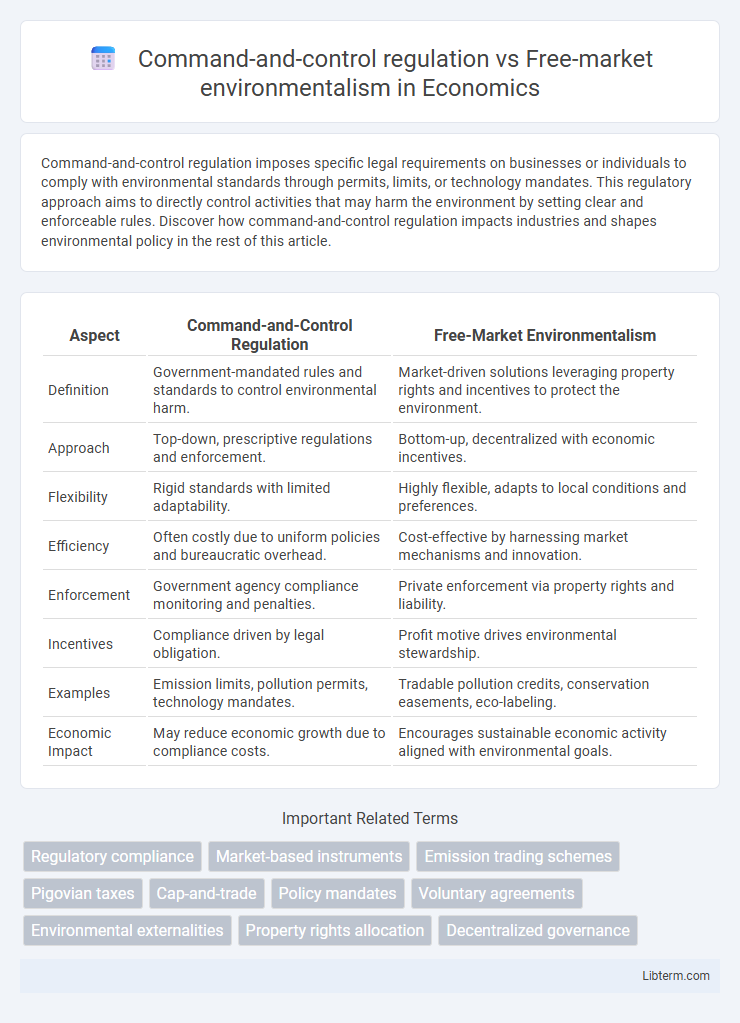Command-and-control regulation imposes specific legal requirements on businesses or individuals to comply with environmental standards through permits, limits, or technology mandates. This regulatory approach aims to directly control activities that may harm the environment by setting clear and enforceable rules. Discover how command-and-control regulation impacts industries and shapes environmental policy in the rest of this article.
Table of Comparison
| Aspect | Command-and-Control Regulation | Free-Market Environmentalism |
|---|---|---|
| Definition | Government-mandated rules and standards to control environmental harm. | Market-driven solutions leveraging property rights and incentives to protect the environment. |
| Approach | Top-down, prescriptive regulations and enforcement. | Bottom-up, decentralized with economic incentives. |
| Flexibility | Rigid standards with limited adaptability. | Highly flexible, adapts to local conditions and preferences. |
| Efficiency | Often costly due to uniform policies and bureaucratic overhead. | Cost-effective by harnessing market mechanisms and innovation. |
| Enforcement | Government agency compliance monitoring and penalties. | Private enforcement via property rights and liability. |
| Incentives | Compliance driven by legal obligation. | Profit motive drives environmental stewardship. |
| Examples | Emission limits, pollution permits, technology mandates. | Tradable pollution credits, conservation easements, eco-labeling. |
| Economic Impact | May reduce economic growth due to compliance costs. | Encourages sustainable economic activity aligned with environmental goals. |
Introduction to Environmental Regulatory Approaches
Command-and-control regulation involves government-mandated limits and standards on pollution emissions, imposing specific technologies or practices to achieve environmental goals. Free-market environmentalism relies on property rights, market incentives, and economic tools like tradable permits to encourage voluntary reduction of environmental harm. Both approaches aim to address environmental externalities but differ in enforcement mechanisms and flexibility in compliance.
Defining Command-and-Control Regulation
Command-and-control regulation refers to government-imposed rules that mandate specific limits or technologies to control environmental pollution and resource use. This regulatory approach relies on legally enforceable standards, such as emission limits or technology mandates, to achieve environmental objectives. It contrasts with market-based strategies by imposing direct constraints rather than using economic incentives to influence behavior.
Overview of Free-Market Environmentalism
Free-market environmentalism emphasizes the role of private property rights and market incentives in promoting environmental stewardship, arguing that well-defined property rights encourage resource owners to manage assets sustainably. This approach contrasts with command-and-control regulation by relying on decentralized decision-making and competition to reduce pollution and conserve natural resources efficiently. Studies show that market-based mechanisms like tradable permits and environmental offsets can achieve cost-effective environmental outcomes while fostering innovation.
Core Principles and Mechanisms
Command-and-control regulation relies on government-mandated limits and specific technological standards to directly control pollution and enforce compliance through penalties. Free-market environmentalism emphasizes property rights, market-based incentives, and voluntary exchanges to internalize environmental costs and encourage innovation in resource management. Both approaches aim to reduce environmental harm but differ fundamentally in using regulatory authority versus economic mechanisms to achieve sustainability goals.
Historical Context and Evolution
Command-and-control regulation emerged prominently in the mid-20th century as governments responded to escalating environmental crises by imposing strict limits and standards, exemplified by the U.S. Clean Air Act of 1970. Free-market environmentalism gained traction in the late 20th century, advocating for property rights and market mechanisms to address environmental issues more efficiently, influenced by works of economists like Ronald Coase and the rise of environmental economics. The evolution reflects a shift from centralized bureaucratic control towards decentralized solutions leveraging economic incentives for sustainable resource management.
Effectiveness in Achieving Environmental Goals
Command-and-control regulation imposes specific limits or technology standards, ensuring compliance and predictable environmental outcomes, particularly for pollutants with well-defined thresholds like sulfur dioxide. Free-market environmentalism relies on property rights and market incentives, such as tradable emissions permits, promoting cost-effective innovation and flexibility, often resulting in lower compliance costs and dynamic adaptation. Studies show hybrid approaches combining strict regulatory baselines with market mechanisms tend to achieve environmental goals more efficiently by leveraging enforcement certainty and economic incentives.
Economic Impacts and Efficiency
Command-and-control regulation imposes specific limits and mandates on pollution levels, often leading to higher compliance costs and reduced economic efficiency due to inflexible rules and administrative overhead. Free-market environmentalism leverages property rights and market-based incentives, such as tradable permits or pollution taxes, to encourage cost-effective pollution reduction and innovation, fostering economic growth alongside environmental protection. Empirical studies show market-based approaches typically yield greater economic efficiency and lower costs for achieving environmental goals compared to rigid regulatory frameworks.
Case Studies and Real-World Examples
Command-and-control regulation, exemplified by the U.S. Clean Air Act, mandates specific pollution limits and technology standards, leading to measurable improvements in air quality but often with high compliance costs. In contrast, free-market environmentalism, illustrated by tradable pollution permits in the Acid Rain Program, leverages market incentives to reduce emissions cost-effectively, encouraging innovation and flexibility among firms. Case studies from California's cap-and-trade program also show how combining regulatory frameworks with market-based solutions can optimize environmental outcomes while supporting economic growth.
Strengths and Limitations of Each Approach
Command-and-control regulation enforces specific environmental standards and penalties, ensuring compliance through legal authority and clear mandates that can quickly address pollution and protect public health; however, it often lacks flexibility, can result in high administrative costs, and may stifle innovation. Free-market environmentalism leverages property rights and market incentives to encourage conservation and pollution reduction, promoting cost-effective solutions and innovation driven by economic self-interest, but it may fail to adequately address public goods problems and requires well-defined property rights to function effectively. Both approaches offer valuable tools for environmental management, with command-and-control suited for urgent and uniform interventions and free-market mechanisms excelling in fostering voluntary, decentralized improvements.
Future Trends and Policy Implications
Future trends in environmental regulation indicate a shift towards integrating command-and-control frameworks with market-based tools to enhance flexibility and cost-effectiveness in achieving emissions reductions. Policymakers increasingly emphasize hybrid approaches, combining strict emission caps and technology standards with tradable permits and carbon pricing to incentivize innovation and sustainable investment. This convergence aims to balance regulatory certainty with economic efficiency, promoting scalable solutions for climate resilience and resource management.
Command-and-control regulation Infographic

 libterm.com
libterm.com